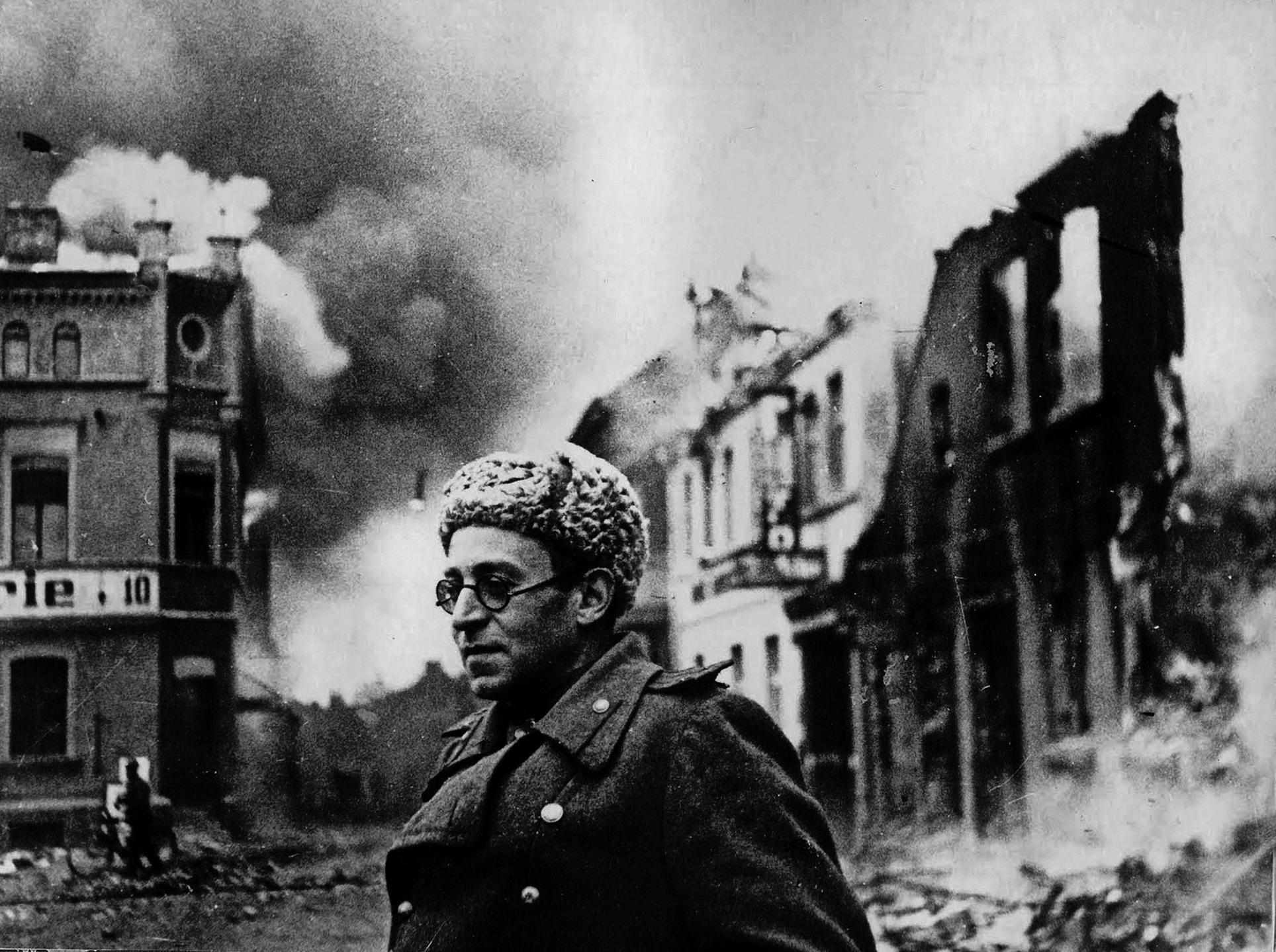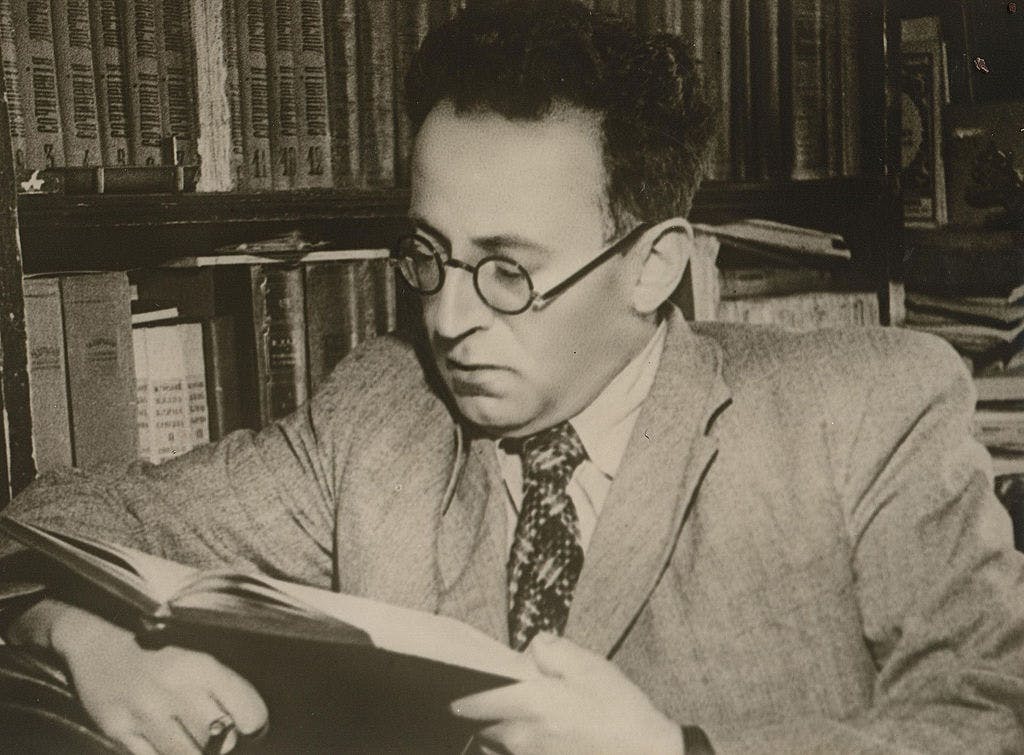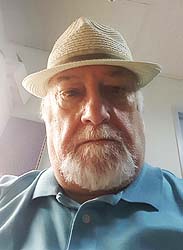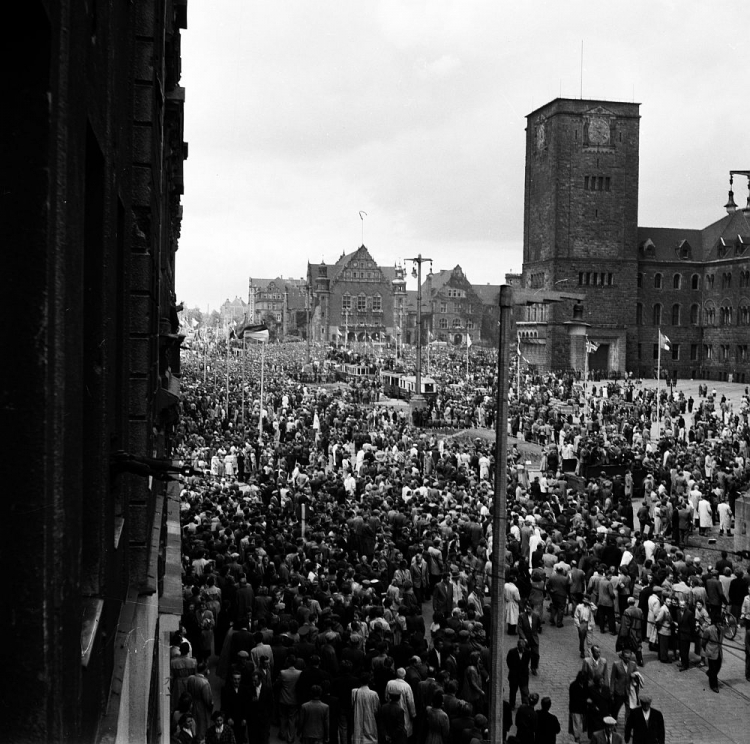Robert Chandler
Vasily Grossman was not only a great correspondent in World War Two but a courageous dissident
 Vasily Grossman in Schwerin, Germany, 1945: Red Army soldiers felt at ease with him
Vasily Grossman in Schwerin, Germany, 1945: Red Army soldiers felt at ease with him
From august 1941 until 1945, Vasily Grossman was a correspondent for Red Star, a daily military newspaper as important during those years as Pravda and Izvestia, the official newspapers of the Communist Party and the Supreme Soviet. Many of the best writers of the time wrote for Red Star and it was read by both soldiers and civilians.
According to David Ortenberg, its chief editor, Grossman’s 12 long articles about the Battle of Stalingrad not only won him personal acclaim but also helped to make Red Star itself more popular. Red Army soldiers saw Grossman as one of them — someone who chose to share their lives rather than merely to praise Stalin’s military strategy from the safety of an army headquarters far from the front line.
Grossman’s articles remain of interest for two reasons. First, they provide the basis for several sections of Stalingrad, the great novel that is the prequel to Life and Fate. Second, they are a model of vivid, thoughtful and truthful journalism. I am not aware of any English-language equivalent to them.
The reader feels no doubt that Grossman is writing about real people and real events
“The Axis of the Main Attack” — the best-known of these articles — is an account of the defence of one of the three giant Stalingrad factories against six weeks of unremitting German tank, air and infantry attack. The clarity of visual and other sensory detail makes the article entirely convincing; the reader feels no doubt that Grossman is writing about real people and real events.
In an often-quoted passage, Grossman focuses on those whose heroism usually goes unnoticed: “Heroism was an everyday habit . . . It was there in the work of cooks cleaning potatoes beside the scorching flames of incendiary shells. There was great heroism in the work of the medical assistants, schoolgirls from Tobolsk — Tonya Yegorova, Zoya Kalganova, Vera Kalyada, Nadya Kasterina, Lyolya Novikova and many others” The list of names both brings the article down to earth and gestures towards the Homeric epic. It testifies to Grossman’s determination to remember individuals, not to allow tragedy to dissipate into mind-numbing statistics.
Even at his most eloquent, Grossman is always memorably direct:
“That morning Markelov’s regiment emerged from the earth … It left its dugouts and trenches … His battalions advanced, with all the hell of the Luftwaffe above them. An iron wind struck them in the face, yet they kept moving forward — and once again, probably, the enemy was gripped by a superstitious fear: Were these truly men marching towards them? Were they mortal? …Yes, they were ordinary mortals and few of them survived, but they did what they had to do.”
Like most of these articles, this was republished many times in the Soviet Union. And the sentences italicised above were incorporated in the vast Stalingrad war mausoleum opened in 1967. Here, though, we encounter a striking example of the Soviet establishment’s ambivalent attitude towards literature. On the one hand, the state needed good writers to propagate its ideology; on the other hand, good writers tend to be independent-minded and therefore a source of trouble.
In huge granite letters on the wall leading up to the mausoleum a German soldier asks, “They are marching towards us again; are they mortal?” Inside the building the Russians’ reply is tooled in gold: “Yes, we were mortal indeed, and few of us survived, but we all carried out our patriotic duty before holy Mother Russia.” Grossman’s words have been edited; the Red Star version ends more simply. Nevertheless, this is clearly a quotation — yet there is no mention of Grossman’s name.
It has recently come to light that Yevgeny Vuchetich, the chief architect, always wanted to use these words but was initially denied permission; this was, after all, only a few years after the “arrest” in 1961 of the typescripts of Life and Fate, one of the most outspokenly anti-Soviet of Grossman’s works. In the end, the authorities compromised: Vuchetich was allowed to use the words as long as their authorship was not acknowledged. Such compromises were far from uncommon in the Soviet Union. Andrey Platonov’s moving and witty versions of Russian folktales, for example, were often included in school textbooks — with no mention of Platonov’s name.
Three of Grossman’s articles are devoted to individuals: a sniper by the name of Anatoly Chekhov; a sergeant in charge of a Volga ferry crossing; and an anti-tank rifleman. All three are a far cry from the simplistic propaganda one might expect from an army newspaper. Each about 2,500 words, they are complex portraits of living human beings.
Gromov, the anti-tank rifleman, is described as irritable, obstinate and intolerant. Many writers would have sought out something to balance his severity, perhaps adding a few words about his sense of humour or his love of his family. Grossman, however, only continues to emphasise his grimness, saying how difficult his life had been even before the war. Some readers might have wondered if this was a reference to the horrors of total collectivisation; this seems all the more likely given that a similarly grim anti-tank rifleman in Stalingrad had spent time in the Gulag.
Grossman’s evocation of Gromov’s first experience of combat is still more unexpected: “Both in front of the men and behind them were walls of white and black smoke and yellow-grey dust. This is what is customarily called ‘hell’. And in the midst of this hell, Gromov had lain down at the bottom of a slit trench, stretched out his legs and begun to doze. A strange sense of inner peace came to him at such moments. He had kept on marching; he had not given in. He had kept up with the others; he had carried his anti-tank rifle all the way. He had kept going, as if on his way to a house of peace and love, as if he were a sick traveller on his way home, scared of halts, moved only by the desire to see his nearest and dearest. Several times during the march he had thought he might collapse. But he had kept on to the end. And now he was lying on the floor of a slit-trench, hell was howling with a thousand voices — and he was dozing, stretching out his exhausted legs. His was the scant, stern rest of a soldier.”
An anti-tank rifle is heavy. It is not for nothing that Gromov has been afraid he might collapse. He also suffers from an unidentified stomach complaint. His comrade, Valkin, has begged their sergeant, to no avail, to give him some vodka, thinking this will sort out his stomach. He is afraid that, when the German tanks move forward, Gromov will fail to get up from his trench. Nevertheless, when the moment comes, Gromov leaps to his feet. “He was breathing quickly and loudly. His sharp, avid gaze took in the tanks now approaching … ‘I don’t need your vodka,’ he said all of a sudden. And Valkin didn’t recognise his voice. It was loud and merry, as if his number one had suddenly been freed of his illness.” Gromov is an individual — and as such, unpredictable.
Ortenberg initially tried to interview Gromov himself. Unable to elicit more than a few words from him, he commissioned Grossman. Setting about this with his usual conscientiousness, Grossman spent a whole week with this anti-tank unit, becoming — in Ortenberg’s words — “like one of the family.” Almost every memoirist has remarked on Grossman’s gift for getting even the most taciturn people to talk freely to him. Grossman’s subjects clearly felt deeply at ease with him — in part, perhaps, because he never took notes during interviews and in part because of his evident interest in their life as a whole, not only in their wartime experiences.
 Vasily Semyonovich Grossman (1905-1964). (Photo by Fine Art Images/Heritage Images/Getty Images)
Vasily Semyonovich Grossman (1905-1964). (Photo by Fine Art Images/Heritage Images/Getty Images)
‘‘The Stalingrad battle” — an account of the surprise attack launched by General Rodimtsev immediately after crossing the Volga — is the basis for several chapters of Stalingrad. Nevertheless, it includes at least one unusual passage for which there is no equivalent in the novel: “The Division had entered into the rhythm of the battle. The men’s breathing, the beating of their hearts, their snatched moments of sleep, the commanders’ orders, the artillery fire, the shots fired from machine guns and anti-tank rifles — everything was a part of this rhythm. Nothing, I thought, could be harder than to acquire this sense of rhythm — and to hang on to it while German dive-bombers swooped down, while the German infantry kept up their attacks day and night, while the evening twilight diffused its deceptive calm, or while dozens of tanks made sudden advances now at dawn, now at three in the afternoon. The rhythm of a storm. The rhythm of the Battle of Stalingrad.”
A later paragraph contradicts a widely-held view that what enabled the Russians to stand their ground was simply lunatic, suicidal courage, fear of the NKVD, a sense that they had nothing to lose, and a great deal of vodka: “The plan of attack impressed me by its great detail and complexity. The apartment block and all the neighbouring buildings had been precisely drawn on a map. Symbols indicated the presence of a light machine gun in the third window on the first floor, of a heavy machine gun at a window on the second floor and of snipers at two other windows on this floor. The whole block — every floor, every window, every entrance to it — had been thoroughly reconnoitred. Mortar gunners, snipers, sub-machine-gunners and infantrymen with hand grenades were to join in the attack … Each branch of arms had its specific task, strictly coordinated with the general objective, and all were in close communication. Operations were directed by wireless, telephone and a system of light signals. The guiding principle of the plan was both simple and complex: the goal would have been clear to a child, but the paths towards it seemed so complex as to make sense only to someone extremely well versed in military matters.”
Taken together, these two passages exemplify Grossman’s unshakable sense of balance. He understands the need for clear, rational planning, yet he acknowledges that in war — as in other realms of life — much depends on more intuitive ways of understanding. For Grossman, Rodimtsev is an artist — clear-minded, scrupulous in his preparations, but never losing touch with his sense of rhythm, with his ability to listen.
The article “Tsaritsyn-Stalingrad” holds a very different interest. Ortenberg writes, “We sent Grossman a telegram asking him to write an article titled ‘Stalingrad-Tsaritsyn.’ What I intended was clear enough: to show how the heroic traditions of the Civil War were being revived in the Battle of Stalingrad. We all know that Stalin claimed the credit for the Civil War victory and he certainly played a part in getting the city to be renamed. [In recognition of Stalin’s role in defending Tsaritsyn during the Civil War, the city was renamed Stalingrad in 1925.] Our historians and men of letters had written a great deal about ‘the chief hero’ of the Tsaritsyn epic. Grossman was well aware of all this. And yet, in his article, he did not say one word about Stalin’s ‘exploits’ in that battle. In those days, that demanded considerable courage.”
Grossman’s silence about Stalin is indeed remarkable. In Stalingrad, however, he goes a step further. Rather than merely keeping silent about Stalin, he has the audacity to joke about the mythologising of the Civil War battle: “When he was young, Polyakov had … served in the Red Army … Politinstructor Shumilo took it into his head to organise an evening discussion, so that the old veteran could talk about the defence of Tsaritsyn. Soldiers were invited from the other units, but the discussion did not turn out as planned. Intimidated by the sight of dozens of people all come to listen to him, Polyakov stuttered for a while, then fell silent. After a moment or two, he recovered himself, sat down on the ground and, as if just chatting over a glass of beer with one of his mates, continued with wild vivacity.
With astonishing recall of every detail, encouraged by the smiles of his audience, he talked about what they had been given to eat, listing the exact quantity of millet, the number of sugar lumps and the weight of their rations of corned beef and dried rusks. He spoke with particular feeling about a certain Bychkov, who, twenty-one years ago, had stolen a bottle of moonshine and a pair of new boots from his haversack. Shumilo had to take over and give a proper lecture about the defence of Tsaritsyn, although he himself had been only two years old at the time.”
This is both endearing and convincing. And it does indeed testify to great courage on Grossman’s part.
Grossman left Stalingrad on 3 January, 1943, after Paulus’s Sixth Army had been encircled, but before Paulus surrendered. He had, however, in his own low-key way, already celebrated the Soviet victory. In “Today in Stalingrad,” published on New Year’s Day, 1943, by which time the Germans had almost entirely run out of both food and ammunition, he had written, “The Russian soldier has come out from the earth. He has come out from the stone. He has drawn himself up to his full height and is now walking calmly and unhurriedly, in bright sunlight, across the glittering, now ice-fettered Volga … In the sunshine, a postman with a leather bag is wandering slowly towards a battalion command post. Two orderlies are crossing a small hill, walking tall and carrying thermoses of soup, only forty metres from the German trenches. Yes, the soldiers have won back the sun, they have won back the daylight, they have won back the right to walk tall, beneath a pale blue sky, across the earth of Stalingrad. They have won back the day.”
Grossman celebrates not the generals, but orderlies, rank-and-file soldiers and a postman
Here, Grossman celebrates not the generals, but orderlies, rank-and-file soldiers and a postman. As always, his writing is multi-layered. He writes simply and factually, but this does not exclude a more spiritual perspective: the Red Army soldiers have “come out from the earth … and the stone.” They have done more than win a military victory; they have been resurrected.
Few great writers have ever responded immediately to world-shaking events; usually they have needed time. Tolstoy, for example, wrote War and Peace more than 50 years after Napoleon’s invasion of Russia. Grossman is an exception; he began work on Stalingrad only months after the end of the battle.
Memoirists have expressed their surprise at the speed with which Grossman was able to construct long, thoughtful articles. A story told by his colleague Yury Levin exemplifies how deeply he was able to ponder events even as they unfolded around him. Levin relates how he and Grossman were making their way to the commanding height of Mamaev Kurgan: “As we emerged from the ravine, we came under fire from six-barrelled mortars. We lay on the ground. The mortar bombs stopped. We got to our feet. We covered another twenty metres. The mortars started up again. I threw myself to the ground. Then I saw that Grossman was still on his feet, still moving forward. ‘Lie down!’ I yelled. ‘Lying down is not difficult,’ he replied. ‘Getting to one’s feet is significantly more difficult.’ He was indeed in a bad way, breathing heavily and with difficulty. He was clearly not well. And he did not lie down.”
recomended by: Leon Rozenbaum

Levin does not remark on this, but Grossman’s words constitute a complex literary allusion. In December 1925 Sergey Yesenin, the most popular poet of the day, had committed suicide, writing a farewell poem which ends, “To die is nothing new — but then, / what new is there in life?” Saying he was afraid that this might demoralise other Soviet writers, Mayakovsky gently parodied these lines: “In this life it’s not difficult to die — / to construct life is significantly more difficult.” And then, in April 1930, Mayakovsky himself committed suicide. In pain and considerable danger, Grossman was meditating on Russian literary history and humanity’s capacity to both construct and destroy. And he was able to distill his thoughts into two simple sentences about lying down and getting up again.
Grossman’s Stalingrad articles provide a complete picture of what was probably the turning point of the Second World War. Unsurprisingly, they have been republished many times. In 1945 and 1946 three editions of a collection titled The Years of War were published in Moscow alone. Similar volumes were brought out in other Soviet cities and the book was translated into English and many other languages. Some of the most interesting material is included in Antony Beevor’s A Writer at War.
Unfortunately, there are serious omissions from all these collections. A single Russian volume drawing on both published texts and unpublished typescripts would be of immense value. But Grossman is not a fashionable writer in Putin’s Russia and few Western scholars seem willing to devote themselves to long months of punctilious textological research in Moscow archives. And so much of Grossman’s journalism and fiction is still only available in heavily censored editions.
Grossman is not — as was once thought — a dull and conventional Soviet writer who suddenly metamorphosed during the 1950s into a brilliant and courageous dissident. His work is vivid and courageous even when — as with his Red Star articles — he was embedded in the heart of the Soviet military establishment. He is now winning worldwide acclaim, but in many instances we have only a vague idea of what he actually wrote. I very much hope this will be remedied soon.
 Śledztwo w sprawie Czerwca 1956: blisko 1,5 tys. przesłuchanych osób
Śledztwo w sprawie Czerwca 1956: blisko 1,5 tys. przesłuchanych osób Poznański Czerwiec 1956. Fot. PAP/CAF
Poznański Czerwiec 1956. Fot. PAP/CAF




